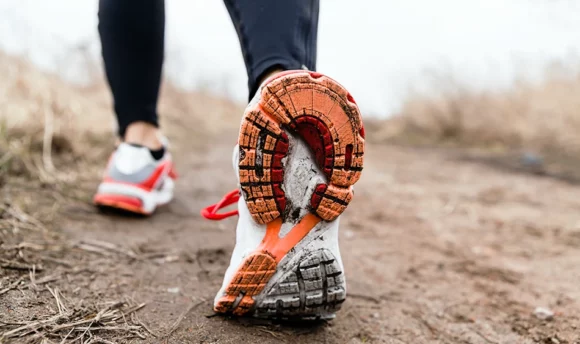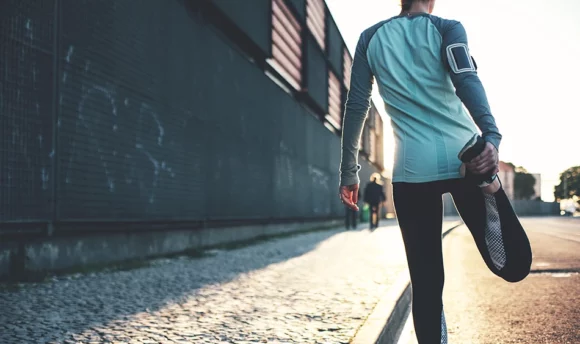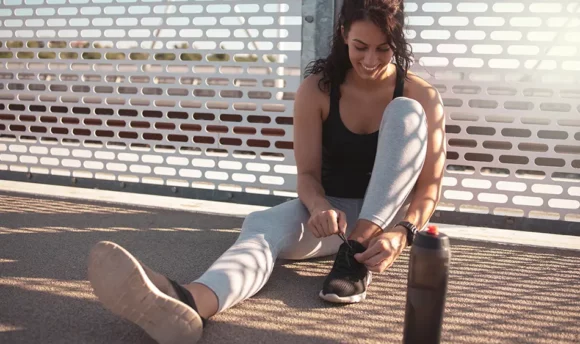8 Running Injuries and Tips on How to Avoid Them
Damaging your body can set back any physical progress. There are many injuries you could get while running, but what are they? We explain several types of common injuries that may occur during a run and helpful tips that encourage you to take more precautionary steps.

Running is a great exercise that supports your health, but there are also risks that come with it.
You might be thinking about certain environments outside. Rocky surfaces and icy paths are dangerous factors for causing injury. However, it’s mainly your posture, shoes, and running technique that increases the risk of physical damage during a strenuous run.
Anyone can hurt themselves while running outside. It’s all about perfecting the movement and running volume to prevent injuries like plantar fasciitis, stress fractures, and shin splints.
Do you want to stay safe on the run? Keep reading to discover potential running injuries someone might get and tips on how to avoid them.
The 8 Most Common Running Injuries
People who push themselves too hard are more likely to cause physical damage. The body can only withstand so much exercise throughout the week. Of course, it’s normal to challenge yourself when achieving new goals, but you should always listen to your body’s needs.
Here are 8 possible injuries you could get while running:
#1 Runner’s knee (patellofemoral syndrome)
Runner’s knee is a dull pain around your knee that worsens during physical activity or when sitting down for too long. The kneecap is usually out of alignment due to consistent overuse. Not resting your legs can cause the cartilage to weaken and trigger sudden bouts of pain.
This type of injury is also caused by a direct impact like falling onto concrete, hypermobile feet, and unbalanced thigh muscles. If certain muscles and joints aren’t in the right place, they put more stress on your kneecaps and surrounding bones, which leaves you with a dull ache.
You might feel more pain when ascending stairs, squatting weights, or bending the knee. Doctors usually recommend people try knee exercises that prevent it from stiffening up. One exercise involves lying on your back and raising your leg straight at a 45-degree angle.
#2 Stress fracture
A stress fracture is another overuse injury that occurs when muscles are too fatigued. Your feet and legs struggle to absorb the impact of the ground while you’re running. This stress overwhelms the bones and causes tiny cracks to form in the tarsals or metatarsal bones.
Some people even get stress fractures in their lower legs. It just depends on how long you run and what type of running shoes you wear. You might notice common symptoms like tenderness around the foot, painful swelling, purple bruising, and throbbing that worsens.
Doctors will tell you to rest as much as possible until the stress fracture heals. You could apply ice to reduce the swelling and ease some pain around the foot or leg. Just remember that consistent rest during the week is important if you want the bone to heal naturally and quickly.
#3 Shin splint
Shin splints refer to the pain or tenderness surrounding the tendons, bone tissue, and muscles around your tibia. This is the shinbone that controls many movements in your lower leg. People often get this type of injury due to hard exercise that triggers inflammation deep in the muscle.
You might experience sharp pain and soreness along each side of your shinbone. There could also be swelling that increases throughout the day. Of course, this common overuse injury doesn’t cause serious damage to your lower leg, but it’s important to rest with shin splints.
Always wear running shoes that are not worn out, and make sure you take breaks. Running for long periods of time can actually weaken your bones and muscles because they aren’t resting. It might be tempting to go for long-distance runs regularly but always listen to your body first.
#4 Achilles tendinopathy
Achilles tendinopathy is pain and inflammation in your Achilles tendon. This connects the calf muscle to your heel bone. You might get a combination of swelling and pain if you put repetitive or intense strain on your feet, so it’s important to give your lower body a rest now and then.
Damage to the Achilles tendon can also trigger stiffness after sitting down, burning sensations, tenderness when standing on your toes, and difficulty walking. Speak to a medical professional if you struggle to walk since the injury might actually be a broken bone or stress fracture.
Some other names for this injury include Achilles tendinitis. Doctors might refer you to a physiotherapist who can treat your foot or provide a course of medication. There are even exercises for Achilles tendinitis that stop bones from seizing due to the lack of movement.
#5 Muscle or ankle strain
A common strain is the tearing of muscle fibers after vigorous movement. The torn tendon or muscle can cause dull pain that stops you from running properly. People usually get a muscle or ankle sprain, depending on how weak their legs are and how much they run in a single week.
Strains are one of the most common running injuries. You can even get one from lifting something heavy or twisting a limb the wrong way at the gym. There are some people who get strains regularly in one or both knees due to the hard impact of the ground during a run.
The top things you can do is rest, take painkillers, and use ice on the swollen area. You may not need medical treatment since most strains settle down after 2–3 weeks. As tempting as it might be at the moment, don’t go on any running sessions to avoid more serious muscle tears.
#6 Plantar fasciitis
Plantar fasciitis refers to the inflamed tissue surrounding your heel bone. Fascia is a tough piece of tissue that connects the heel to your toes, which can cause plenty of pain when damaged. Runners often get this injury from uncomfortable running shoes or uneven walking surfaces.
You can get soreness on the bottom of your foot and pain along the sole. This tenderness may worsen when walking or standing for a long amount of time. Speak to a doctor about potential treatments since plantar fasciitis could stop you from moving around and living your life.
Consider wearing orthotics to prevent more common running injuries. It is a device that supports the problematic areas of your feet. Each shoe insert is completely custom to you, whether that’s to lift an arch, reduce heel discomfort, or help compensate for any deformities in toe joints.
#7 Iliotibial band syndrome
Iliotibial band syndrome (IT) is a problem in which a tendon becomes swollen and rubs against your knee or hip bone. This occurs when you’re constantly bending your knee during intense exercise and not giving the tendons a chance to rest.
Your IT is a long tendon that starts at the hip and extends just below the knee. Physical damage causes the IT to rub against surrounding areas and trigger inflammation. Over time, you might notice swelling, thigh pain, knee aches, and a clicking feeling in the leg.
Doctors will prescribe pain relief medicines for this syndrome and suggest strengthening exercises to complete at home. The piriformis stretch is a good movement for the IT. Simply lie on your back with your legs straight and hug your affected leg gently to your chest.
#8 Blisters
Blisters are small pockets of fluid that build up once the skin is damaged. They are usually circular in shape and collect under the top layers of flesh. A blister derives from tight-fitting shoes that rub vigorously against your skin while running or walking long distances.
You should find more comfortable running shoes that protect your feet. It’s also worth sticking bandages on the back of your heels to prevent the skin from rubbing. Other great ways of preventing blisters comprise wearing thick socks and applying powder to problematic areas.
Other Possible Running Injuries
There are many other injuries you can get when running outside or on a treadmill. Your body is fragile when it comes to repetitive movements and strenuous exercise. Runner’s knee might be the most common, but that doesn’t mean you won’t get more serious or intricate injuries.
Below are some more injuries that could happen during a run:
- Temperature-related injuries like sunburn or heat exhaustion
- Calf tears
- Posterior compartment syndrome
- Meniscal cyst
- Hoffa’s syndrome
- Medial tibial stress syndrome
- Patellofemoral pain syndrome
- Tight muscles
- Hamstring injuries like muscle strains or tears
- Bruises from falling over
- Cuts and scrapes
How to Avoid Running Injuries?
You can avoid injuring yourself by making a running plan. Think about how far you want to run and when you will take regular breaks throughout the week. Some people also find the right running gear that keeps them safe during season changes and travels on uneven ground.
Here are some tips for preventing a running injury:
- Try stretching
- Do warm-up exercises
- Increase mileage gradually
- Give some time for the muscle to recover
- Improve running form and technique
- Get some high-quality shoes
- Add strength training to your routine
- Listen to your body
- Don’t go overboard
- Take regular breaks during a run
FAQs
Yes, running with a bad posture can affect the quality of your running and increase the risk of injury. Not having a strong upper body may put more stress on the knees, hips, and legs. To avoid repetitive stress on your limbs, keep your head and back straight during the run.
Cross-training exercise is great for strengthening your muscles and bones. Do more aerobic activities like walking, swimming, dancing, and stair climbing to keep your body strong. Even simple morning walks can warm up your muscles and decrease the risk of a running injury.
A Word From Our Coach
Running is a great but dangerous exercise when performed incorrectly. You might have bad posture one day or choose the wrong running shoes. Simple mistakes like these can lead to common injuries that sideline your progress, so it’s important to take actionable steps.
Getting a runner’s knee, Achilles tendinitis, or an IT condition are just a few worries. These overuse injuries will prove that you’re running too much. You also need to consider what shoes are most comfortable and how you can safely navigate uneven and unreliable environments.
For beginners, start walking one mile a day to ease your body into it. Sudden movements are more likely to cause injuries to your lower leg or shin bone. If you have tight calf muscles, do some stretches for 5–10 minutes beforehand to ensure every muscle has loosened up.
Conclusion
Now that you’re aware of potential running dangers, it’s time to take the right steps. Find some comfortable running shoes and monitor your posture throughout the day. Your body will tell you when it needs rest, so use extra days throughout the week to calm your joints and muscles.

















































 Select your language:
Select your language: 








